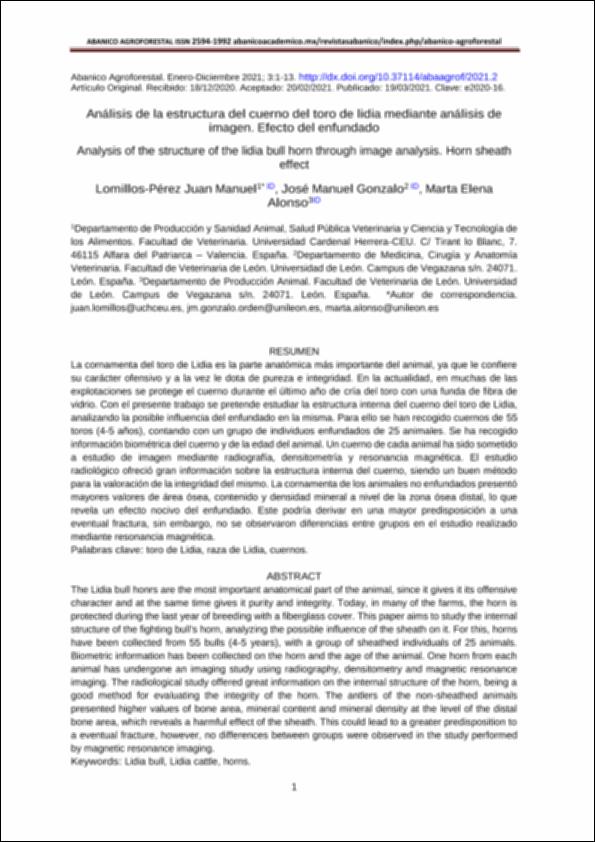Por favor, use este identificador para citar o enlazar este ítem:
http://hdl.handle.net/10637/13726Análisis de la estructura del cuerno del toro de lidia mediante análisis de imagen : efecto del enfundado

Ver/Abrir:
Analisis_Lomillos_AA_2021.pdf
917,54 kB
Adobe PDF
Ver/Abrir:
Analysis_Lomillos_AA_2021.pdf
827,67 kB
Adobe PDF
| Título : | Análisis de la estructura del cuerno del toro de lidia mediante análisis de imagen : efecto del enfundado |
| Otros títulos: | Analysis of the structure of the lidia bull horn through image analysis : horn sheath effect |
| Autor : | Lomillos Pérez, Juan Manuel Gonzalo Orden, José Manuel Alonso de la Varga, Marta Elena |
| Materias: | Diagnóstico por imagen en veterinaria.; Veterinary diagnostic imaging.; Fighting bull.; Cuernos.; Horns.; Toros de lidia. |
| Editorial : | Sergio Martínez González |
| Citación : | Lomillos Pérez, J.M., Gonzalo, J.M. y Alonso, M.E. (2021). Análisis de la estructura del cuerno del toro de lidia mediante análisis de imagen : efecto del enfundado. Abánico Agroforestal, vol. 3 (en. 2021), pp. 1-13. DOI: http://dx.doi.org/10.37114/abaagrof/2021.2 |
| Resumen : | La cornamenta del toro de Lidia es la parte anatómica más importante del animal, ya que le confiere
su carácter ofensivo y a la vez le dota de pureza e integridad. En la actualidad, en muchas de las
explotaciones se protege el cuerno durante el último año de cría del toro con una funda de fibra de
vidrio. Con el presente trabajo se pretende estudiar la estructura interna del cuerno del toro de Lidia,
analizando la posible influencia del enfundado en la misma. Para ello se han recogido cuernos de 55
toros (4-5 años), contando con un grupo de individuos enfundados de 25 animales. Se ha recogido
información biométrica del cuerno y de la edad del animal. Un cuerno de cada animal ha sido sometido
a estudio de imagen mediante radiografía, densitometría y resonancia magnética. El estudio
radiológico ofreció gran información sobre la estructura interna del cuerno, siendo un buen método
para la valoración de la integridad del mismo. La cornamenta de los animales no enfundados presentó
mayores valores de área ósea, contenido y densidad mineral a nivel de la zona ósea distal, lo que
revela un efecto nocivo del enfundado. Este podría derivar en una mayor predisposición a una
eventual fractura, sin embargo, no se observaron diferencias entre grupos en el estudio realizado
mediante resonancia magnética. The Lidia bull honrs are the most important anatomical part of the animal, since it gives it its offensive character and at the same time gives it purity and integrity. Today, in many of the farms, the horn is protected during the last year of breeding with a fiberglass cover. This paper aims to study the internal structure of the fighting bull's horn, analyzing the possible influence of the sheath on it. For this, horns have been collected from 55 bulls (4-5 years), with a group of sheathed individuals of 25 animals. Biometric information has been collected on the horn and the age of the animal. One horn from each animal has undergone an imaging study using radiography, densitometry and magnetic resonance imaging. The radiological study offered great information on the internal structure of the horn, being a good method for evaluating the integrity of the horn. The antlers of the non-sheathed animals presented higher values of bone area, mineral content and mineral density at the level of the distal bone area, which reveals a harmful effect of the sheath. This could lead to a greater predisposition to a eventual fracture, however, no differences between groups were observed in the study performed by magnetic resonance imaging. |
| Descripción : | Esta artículo se encuentra disponible en la siguiente URL: https://abanicoacademico.mx/revistasabanico/index.php/abanico-agroforestal/article/view/304/677 |
| URI : | http://hdl.handle.net/10637/13726 |
| Derechos: | http://creativecommons.org/licenses/by-nc/4.0/deed.es |
| ISSN : | 2594-1992 (Electrónico) |
| Fecha de publicación : | 11-ene-2021 |
| Centro : | Universidad Cardenal Herrera-CEU |
| Aparece en las colecciones: | Dpto. Producción y Sanidad Animal, Salud Pública Veterinaria y Ciencia y Tecnología de los Alimentos |
Los ítems de DSpace están protegidos por copyright, con todos los derechos reservados, a menos que se indique lo contrario.

